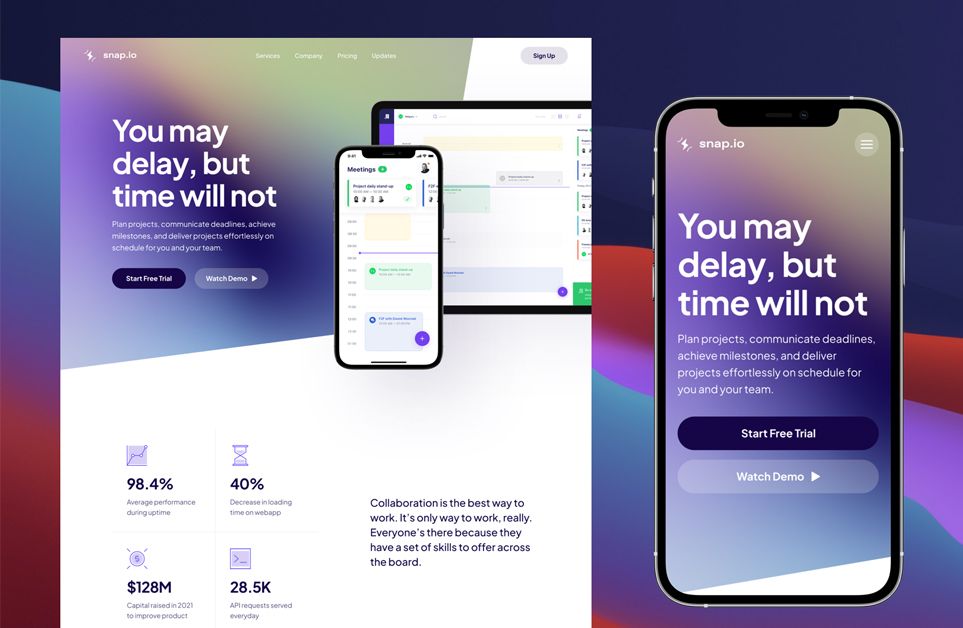
The world of today is ruled by applications and images, and in it, digital design has become the cornerstone. Whether it is the clean layout of a smartphone app or the stylish infographics we see on our timelines, digital design influences all our interactions.
But first, let us understand what is meant by the term digital design. So, to understand that, we will look at digital design and its world in this blog.
This blog will help you understand the basic concepts of digital design. More so, we will discuss the types of digital design as well as its importance and future development.
By reading this blog, anyone, whether it is a new designer, a graphic design agency, or even a logo design firm, will learn everything about digital design. This blog will give you the information you need to excel in the field of digital design.
So, without any further ado, let’s get right into it.
What is Digital Design?
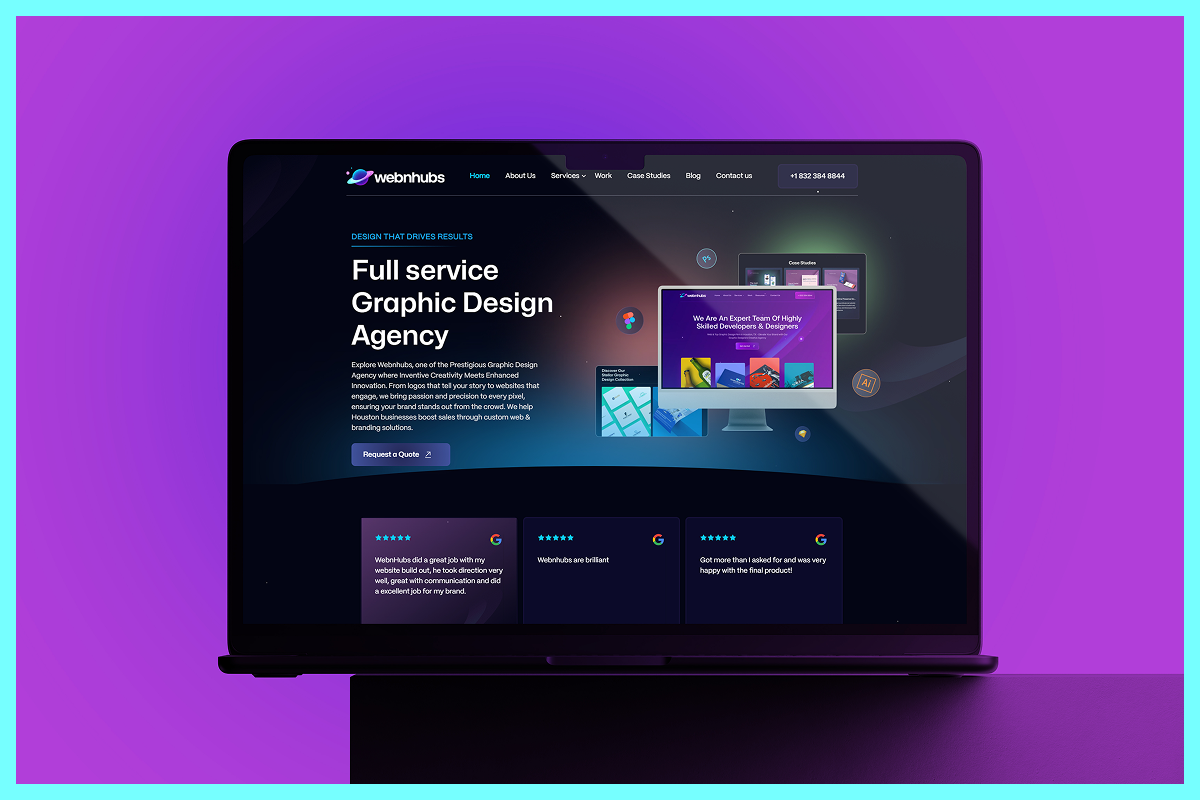
In the simplest of ways, digital design is a creative process that deals with designing and creating pieces of graphic content.
It does that by applying digital instruments for devices and platforms, such as websites, apps, and social media. Graphic design, which is a type of digital design, covers all forms of designs you see on the internet.
This includes web and app design, illustrations, as well as animations, and user interfaces. However, design, on the other hand, is traditionally done using different mediums.
These mediums are created physically. More so, digital design is inherently tied to the digital world. Therefore, it has the opportunity to be dynamic, interactive, and versatile.
Key Aspects of Digital Design
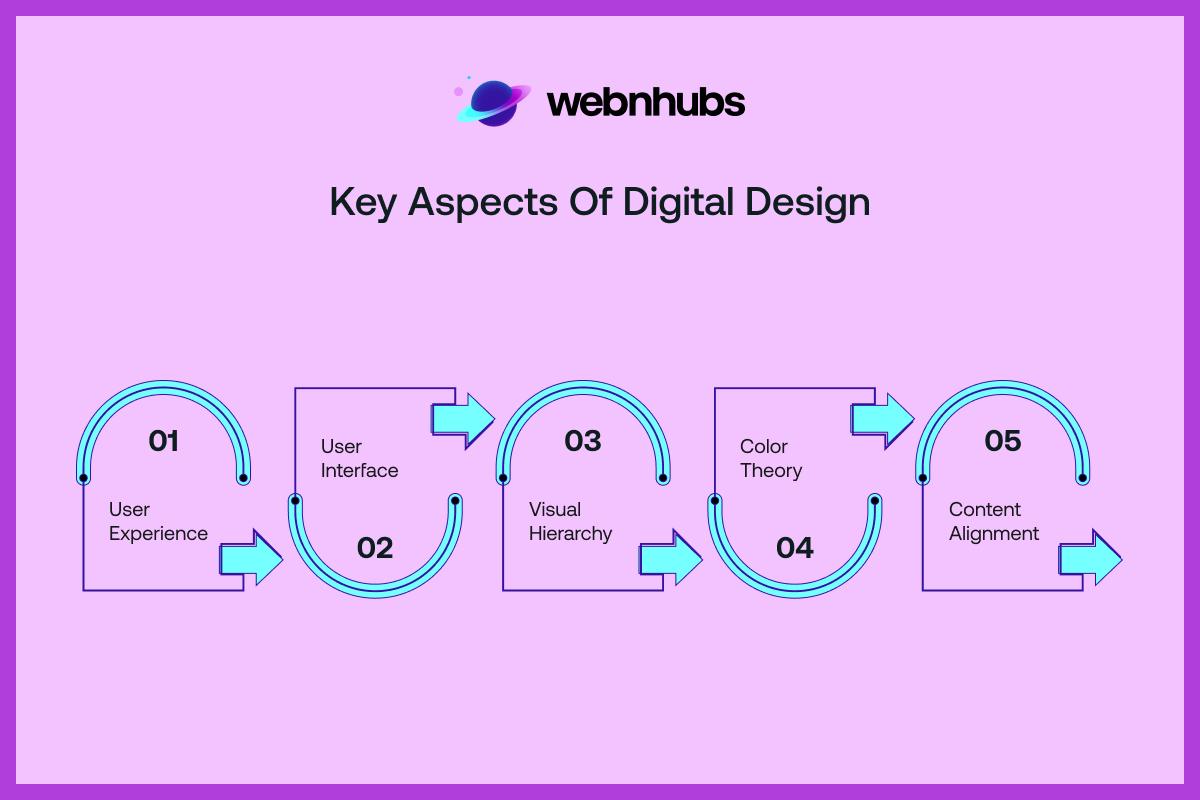
Every designer has to implement a few key aspects to nail the aesthetic and create a good digital design.
These key aspects are maintaining balance, contrast, hierarchy, alignment, repetition, and proximity. More so, understanding symmetry and asymmetry is vital to achieving balance in the design.
When something is off balance, the design is unstable. On the other hand, contrast uses different hues, forms, and types to provide complements to elements. More so, hierarchy helps to arrange elements by focusing on their importance.
It also helps the viewer’s eye to find and look at the thing that matters. Nalining these things allows the viewer to lay their eyes straight on the right point.
The whole thing about alignment is what allows designers to create a design by arranging objects in the right way. This way, designers can produce a design that looks aesthetically spot on.
More so, repetition is quite useful in enhancing design uniformity by depicting recurring features. To create a visual relationship, proximity allows the grouping of related items together. Collectively, these principles make digital designs easy to interact with and enjoyable to use.
6 Qualities of a Great Digital Design
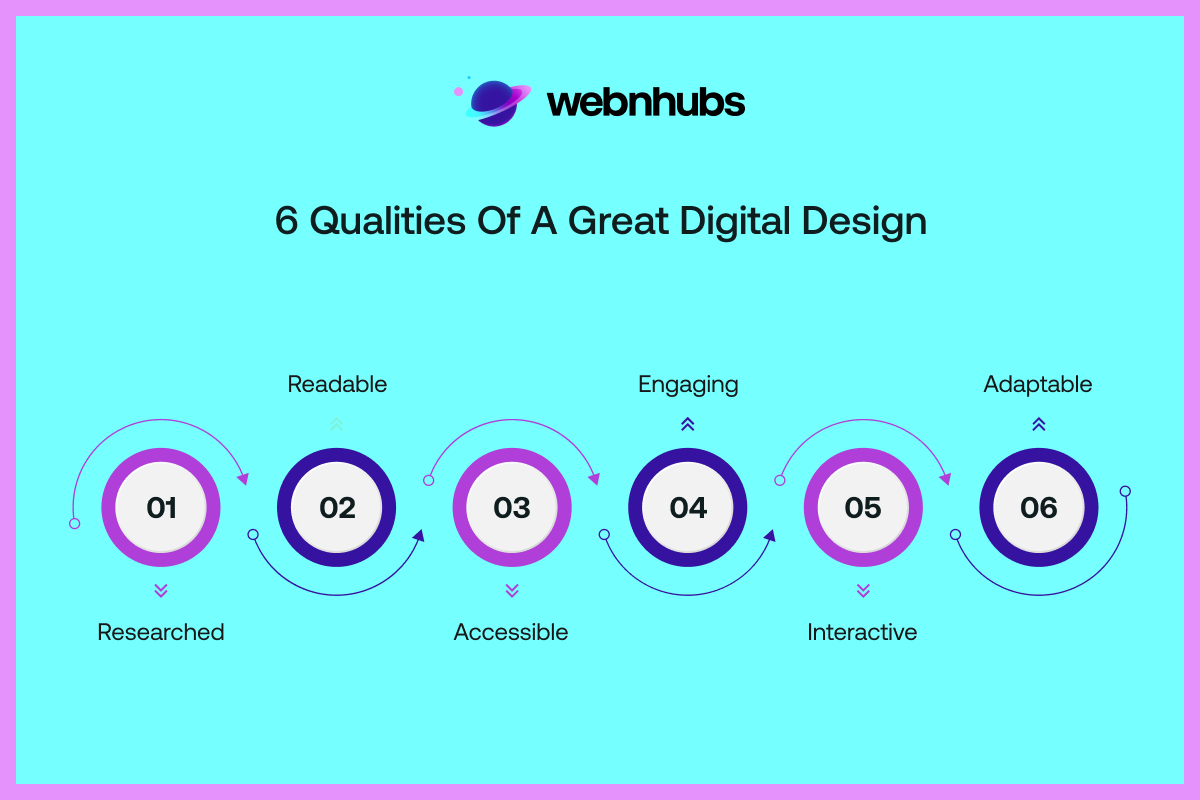
While we already discussed the key aspects of a digital design, it is also important to look at the key components and qualities that make a digital design great and successful.
More so, when creating a digital design, every designer needs to nail these components to achieve aesthetic brilliance.
So, let’s take a look at these 6 components of successful digital design:
1. Researched:
A great digital design is always well thought out and thoroughly researched before being made. Designers research beforehand and plan the design with data to make sure the digital design meets the pain points.
This way, they can create a digital design that delivers the message to the right audience in the right manner.
2. Readable
The best quality of a great design is that it is easy to read and understand. If your design has all the fancy bells and whistles but is not easy to read, then it does not make the cut.
The best tip is to make sure your digital design is clear and readable on all screen sizes. Use basic design principles such as visual hierarchy and white spaces to make the content easy to read and understand.
3. Accessible:
A digital design should be easy to understand. More so, the users can easily interact with digital elements without getting too caught up in design complications.
Make sure your digital design is accessible as accessibility is key to the success of a digital design.
4. Engaging:
A digital design should always be eye-catching and attention-grabbing. It should engage the viewer from the first glance and attract their interest right out of the gate.
More so, the design must reflect your brand image and provide an aesthetically pleasing experience to your users.
5. Interactive:
The quality of a great digital design is that it drives interactions with viewers. A digital design that looks good must also be interactive.
That means it must encourage viewers to participate, click, scroll, input information, and just interact with the design in any way, shape, or form.
A good design will make its presence known and will take advantage of its presence to drive interactions.
6. Adaptable:
A great design always accommodates different users on different devices and different screen sizes. Also, your design must be adaptable to changing technologies so that it does not feel out of place or outdated.
More so, it must have the flexibility to accept additions or improvements to meet the ever-changing design needs.
Types of Digital Design
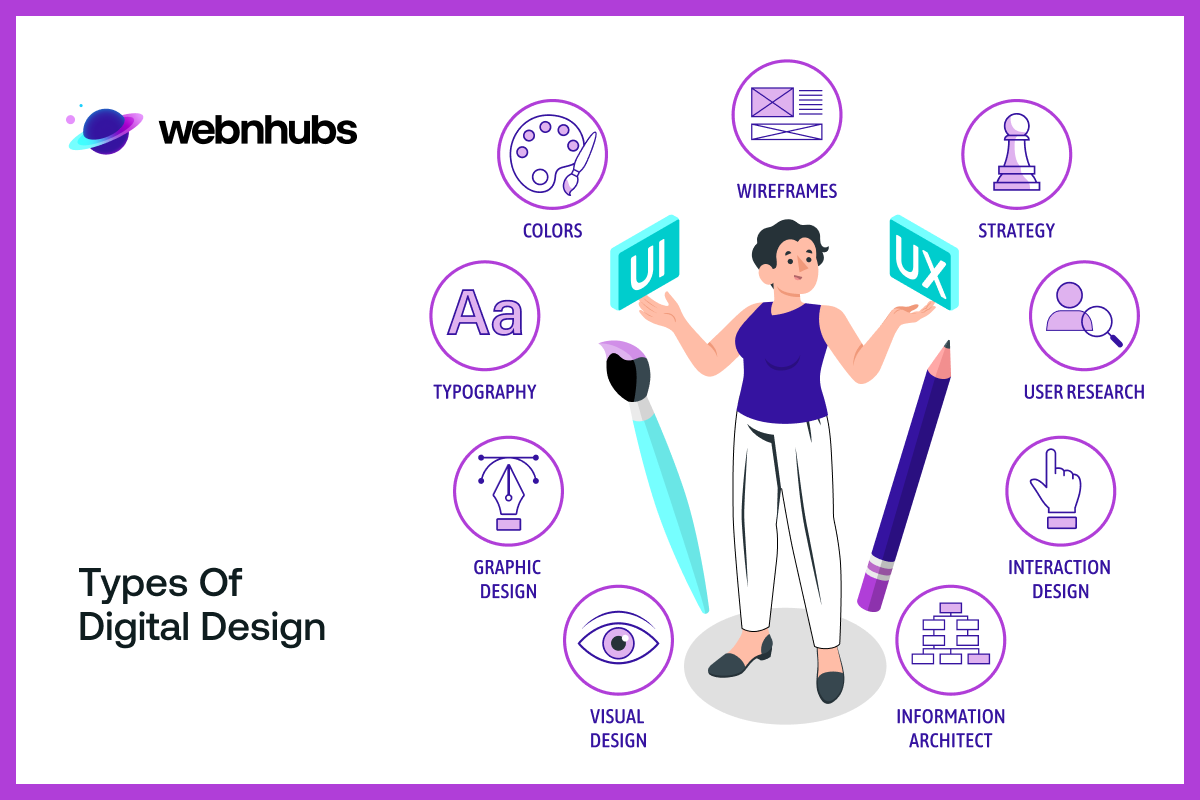
There are a lot of types of digital designs. The world of digital design is nothing short of a vast ocean, or at least it feels that way.
With the world becoming more and more filled with technology, and as digital becomes the norm, the doors for various types of digital designs are opening up.
As of today, there are at least a hundred types of digital types, and they keep growing. That being said, we have picked out the utmost important types of digital design that you and everyone else come across the most on the internet.
“Though digital, your branding should be cohesive across mediums. Explore our Print Design Services to ensure consistency from screen to paper.”
So, these are the main types of digital design:
Web Design
The first and the most recognizable type of digital design is web design. Web design can be defined as the process of designing a website that has an enhanced look.
More so, it is about adding a feel to a site that makes it easy to navigate with the added feature of being able to perform at its best.
It is somehow a combination of graphic design and technology including web development, and user experience design.
Web design is the branch of digital design. Businesses cannot do without a website in the modern world. Just as they cannot go a day without a logo.
There are several ways to design a website, either by hiring a freelancer or by partnering with a web design firm such as Webnhubs.
App Design
The next type of digital design that is just as popular as the first one is app design. Mobile app design involves creating the layouts and features of mobile applications known as the user interface (or its short form, UI).
This type of design always focuses on usability, practicality, and the looks of the app. The app designs are a lot like designs of web pages. However, they are developed with a precise purpose in mind.
That purpose could either be buying groceries, setting a reminder, exchanging messages, or listening to a song, for that matter.
Apps act as primarily digital assets for users. Mobile apps are popular, and it is also possible to have an app that runs on the desktop.
Graphic Design
Graphic design is the most commonly used type of digital design. More so, graphic designing deals with creating visually appealing images that you normally see on the internet.
More so, it is about designing graphic images with content for social media platforms, websites, or even marketing advertisements.
It also includes creating logos, infographics, banners, and any other form of graphical content that is posted on websites and other channels.
Landing Page Design
Landing page design is a specific branch of web design. This type of design puts emphasis on the commercial and business side of things.
While a business website may serve as the core platform containing information about the business, a landing page has a single page. Its focus is on a specific product or service.
This page uses a call to action (CTA) to get leads and conversions. At times, a firm may have a variety of landing pages for its various products or services.
More so, digital designers need to guarantee the landing pages are consistent.
Increase your coversions
You can learn more about landing page design and content by visiting our services
Animation and Motion Graphic
Graphic design in motion refers to the process of creating images, from rudimentary animation to elaborate motion graphics, which are used in films and advertisements, as well as in interactive media.
User Experience (UX) Design
UX design is about making the user’s experience as seamless and efficient as possible when interacting with a product. This includes a lot of evaluation and experimentation to make the gadget as functional and as pleasurable to use as possible.
A User Interface (UI) Design
User interface design is about making designs that users interact with. The process of UI design is similar to the process of UX design, but in the case of UI design, the emphasis is placed on the aesthetic aspect of the particular interface.
It encompasses the arrangement of space, use of colors, fonts, and any other features that are meant to be touched when creating a website.
Social Media Page Design
Social media design includes designing images such as cover images, graphic posts, carousel posts, static posts, stat posts, and poll posts.
More so, it involves creating images that feature the branding side of things, such as logos. Companies use these images to drive user interaction and create an online presence with their custom social media images.
Ebooks Design
The very definition of eBooks is electronic books. Ebooks have become the standard of book writing and reading in these digital times.
And since books have gone digital too, they need digital designs to add visual elements to make them readable. The ebook design usually includes creating the cover design and the interior typesetting.
3D Design
3D designs are used mainly for entertainment, video games, and video animations. However, 3D designs are used in just about every field. As the name suggests, these are three-dimensional images that look realistic.
They are made in the same manner as any other image is made, albeit with the addition of an extra dimension, on a computer.
Graphic design in motion refers to the process of creating images, from rudimentary animation to elaborate motion graphics, which are used in films and advertisements, as well as in interactive media.
Types of Digital Designers
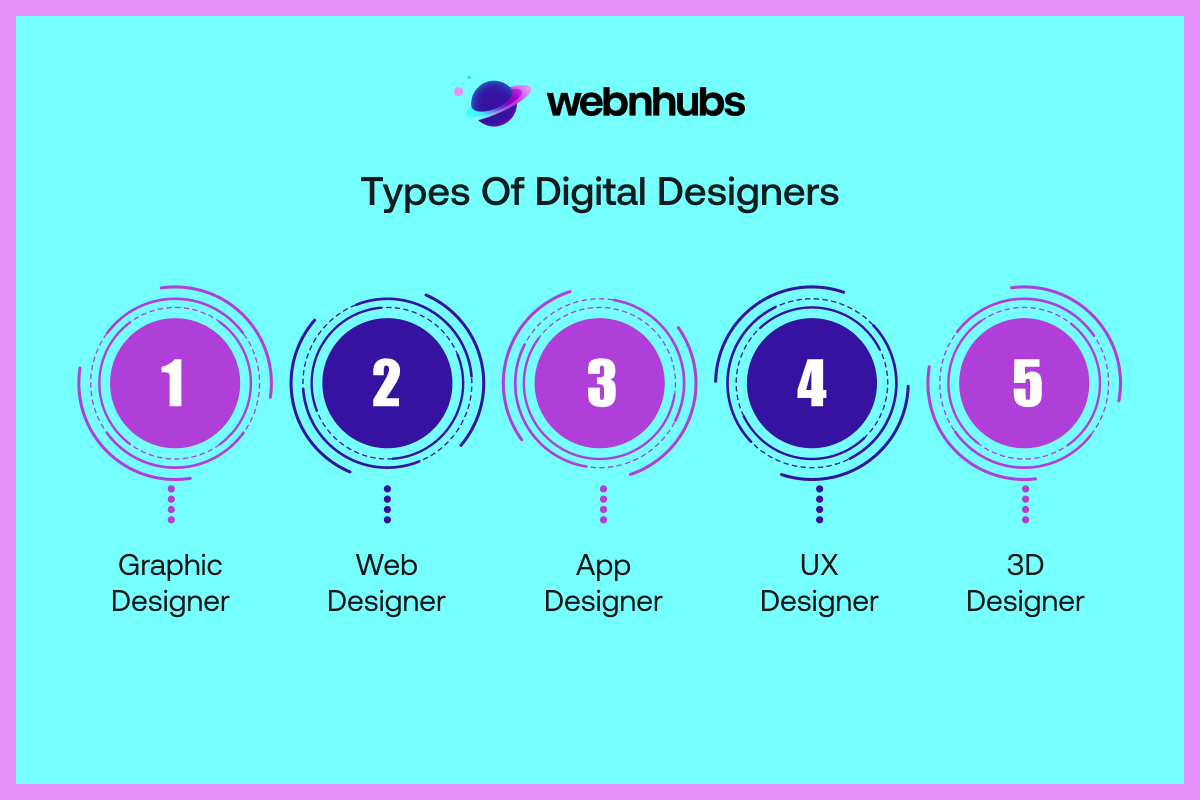
As it is the designs and their different types, the same is the setting for designers. There are different types of design, so naturally, there are different types of designers as well.
The field of designers is a broad one and knowing which type of designer you need to hire will be key to getting your digital design project done.
Therefore, let’s look at the types of digital designers there are around the world:
Graphic Designers
Most digital designers in the world are graphic designers. Graphic design is a bit easier than other types of design.
More so, almost every other type of designer knows graphic design. A graphic designer creates digital images using art direction, typography, icons, and illustrations.
Web Designers
A web designer is a designer who deals with everything related to the design of websites. This type of designer creates layouts and visual designs for websites, landing pages, and other web elements.
They do so using mockups and tools. They are also developers in some cases, with expertise in languages like HTML and CSS to create web pages.
App Designers
App designers are a lot like web designers, albeit they deal with everything related to design for applications. These designers create UI and UX designs for mobile apps that make the apps look and feel good. More so, they are responsible for the elements that the user interacts with on the mobile app.
Animators
An animation designer or animator designs custom animations for companies or media purposes.
These animations are video digital designs that provide a different look and feel than a video. Animators also design animations for websites and create animated logos that play during loading screens.
Comparing and Contrasting Various Designs
Almost all types of design share basic principles. That being said, each design has its unique focus and application as well.
For instance, in Web Design vs. App Design, the web design concerns websites that can be viewed through a browser. On the other hand, app design deals with apps that are run on specific platforms (iOS or Android).
As for Graphic Design vs. Digital Design, graphic design is mostly linked with logos, posters, and printed stuff. At the same time, digital design deals with dynamic designs for the web and apps.
Likewise, when it comes to UX vs. UI Design, the UX design is centered on experience and usability. On the contrary, UI design is more concerned with looks and functionality.
Differences between Graphic Design and Digital Design
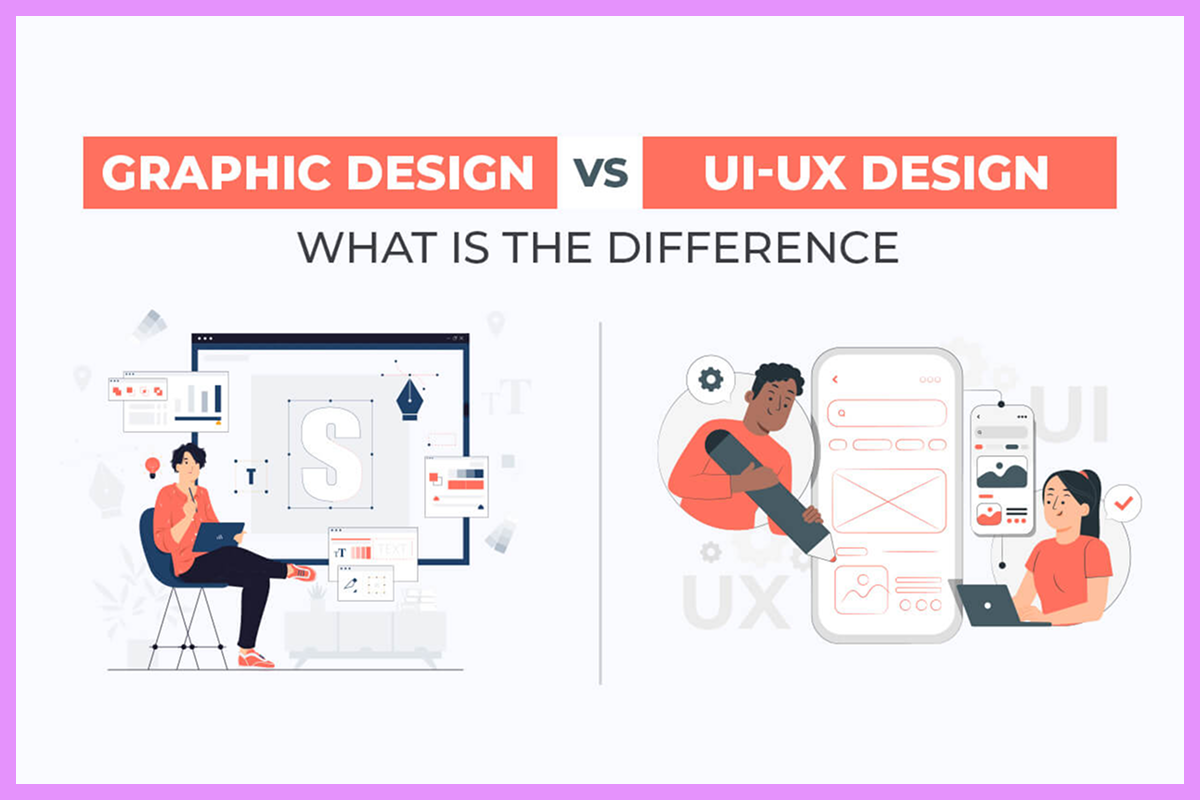
Though both graphic design and digital design are based on the same principles of design, the latter is excellent in its aspects.
More so, the two types of design can be compared in the following ways:
Medium
Graphic design started as a print-based procedure. It is used for creating graphic design for posters, brochures, magazines, and advertisements along with many others. This approach focuses on designing more concrete and fixed information pieces.
These pieces can be shared more easily. On the other hand, digital design exists within digital platforms.
This includes all forms of interactive visual interfaces, including Websites, Mobile app interfaces, social media graphics, and even digital advertisements.
Interactivity
Another notable aspect of digital design is that it includes media that can be used through interactions.
This includes clickable buttons, cartoons, and other provisions for user feedback. These are some of the things digital designs deal with.
More so, they are much more interactive than simple graphic designs. It specifically defines and enforces the interactivity that increases users’ engagement.
More so, it makes digital content more responsive to their actions. Graphic designing is a broad field. However, it is proficient in presenting unambiguous though motionless images and texts that convey the intended messages.
Tools and Techniques
The tools and techniques that are used differently in graphic and digital design. The tools vary and are suited to their respective media and purposes.
Most graphic designers employ computers with graphic arts software like Adobe Photoshop and Illustrator. They use them to create visuals and illustrations.
These tools are ideal for developing patterns that one will use for printing or in static applications only. Digital designers are likely to use such tools as Adobe XD, Figma, and Sketch. These are the primary tools of the trade.
These tools are intended to be used for creating adaptive designs with engaging interactivity. These designs are created for different devices and resolutions, valuing usability as well as looks.
Focus on End-User Experience
Digital design is paramount in ensuring the end user has the best experience possible. This means that the interaction between graphics and other elements does not only have to be pretty but also logical.
Furthermore, it is easy to use and fun. This includes research of the intended users and the creation of mock-up models and iterations to change the design depending on the users’ feedback.
Graphic design, on the other hand, has the overlapping goals of aesthetics. Besides, clarity is more preoccupied with the appearance and functionality of the design in conveying a message.
These two areas of design serve to capture their respective target markets. However, digital design accomplishes this through interactivity and functionality. Graphic design does that through its strong reliance on the visual narrative.
Differences Summarized
Here’s a quick comparison between the two to clarify the differences:
| Feature | Graphic Design | Digital Design |
| Medium | Primarily print-based: posters, brochures, magazines, and ads. | Exists on digital platforms: websites, apps, digital ads, social media, etc. |
| Interactivity | Static visuals with no interactive components. | Interactive elements like clickable buttons, animations, and dynamic feedback. |
| Tools & Techniques | Uses Adobe Photoshop, Illustrator—best for static visuals and print. | Uses Adobe XD, Figma, Sketch—tailored for responsive and interactive UI/UX. |
| User Experience Focus | Focuses on aesthetic clarity and visual messaging. | Prioritizes usability, functionality, and user engagement. |
| Analytics and Tracking | Performance is not easily measurable, especially in print. | Easily measurable with tools that track engagement, clicks, and interaction data. |
| Output Format | Often results in physical output—flyers, banners, or posters. | Entirely digital output—websites, mobile UIs, digital ads. |
| Design Purpose | Designed to be viewed—communicates visually. | Designed to be used—guides interaction, offers functionality. |
| Adaptability | Fixed sizes and layouts, mostly non-responsive. | Responsive design is adaptable across devices and screen sizes. |
| Animation & Motion | Typically static, with limited use of motion. | Often includes animations, transitions, and interactive motion elements. |
| Feedback Loop | Rarely adjusted after printing unless reprinted. | Constant iteration based on user testing and feedback. |
Digital Design Agencies
Digital design agencies deal with designing interfaces for different digital aspects that are stylish and easy to use. These agencies specialize in offering services such as web and application design.
Furthermore, they deal with other things such as branding, digital marketing, graphic and UI and UX design, animations, and other interactive media services.
Most of these agencies have a team of designers, developers, and strategic planners. These people ensure they offer unique services to meet the client’s needs.
How to Choose the Right Agency for Your Business

To find out which agency is the best for your design needs, you need to consider a couple of factors. First and foremost, assess the firm’s portfolio.
This way, you decide if their work meets your project requirements in terms of style and specialization. More so, look for work samples. This way, you can see how they have achieved results in similar projects to yours.
Then after that, define the scope of the agency and its capabilities. See whether they provide a wide range of services that meet your branding vision. Look for how they create UX/UI design, and go with your digital marketing strategies.
Furthermore, you should review their industry experience and expertise. Check the feedback from their clients to know their dependability and reliability.
Another important factor that you should not overlook is how proactive the agency is in communication. More so, check how willing they are to cooperate with the client during the project.
Lastly, look at the pricing and make sure that the agency provides the best value for money in terms of the quality of work they deliver.
A thorough analysis of these factors will help you choose the right digital design firm. The ideal design company will meet your objectives and provide the best digital design solutions.
Why Choose Webnhubs Design Agency?
When it comes to choosing the right digital design agency, there is no better option than Webnhubs. Webnhubs is a design and branding firm. It has been establish as one of the leading agencies.
This leading digital design firm works at the front line. They bring the most design ideas to life. More importantly, they use modern apps and tools to design and provide users with good digital experiences.
Moreover, it is their standard and value of the work that makes them leaders. They deliver quality work that contributes to business success and brand positioning. You can partner with Webnhubs for your digital design project.
Conclusion
The importance of digital design cannot be understated. More so, the fields that represent art and technology use digital design for their work. The digital experience becomes a product of art where functions converge with aesthetics. Designers are the artists of the modern day. They know the balance, contrast, hierarchy, alignment, repetition, and proximity to create designs that are aesthetically appealing and easy to navigate. That is why, if you are a fresher seeking to enhance your knowledge, you must always be on the lookout for current trends.
You must stay with the fashion of design. Also, you should practice to perfect your skills and get feedback on the job to grow in this field. You can use these principles to lay an excellent foundation for your course in digital design. Let us know your thoughts, reactions, or personal experiences in the comments below. Stay connected with us on social media for more design ideas.
Frequently Asked Questions
To start working on digital designs for your brands or business, you need to have brand’s goal and its voice in mind. Design elements like names, logo, brand colors, layout and your target audience are important.
Before starting, do some research to find out about your competitors. Know what they’re doing and how they’re doing and then invest on things that can work.
Once you know your brand values, your target audience and competition, you can then start finding the best tools to work with. There are both free and paid tools, depending on your needs and requirement.
One most important thing is brand consistency. This is what will keep viewers engaged because of the trust and faith you are displaying. All the visuals need to be in sync; the team needs to be in sync.
Last but not the least, ensure better communication, customer support and take frequent feedbacks.
If your focus is on increasing user engagement, work on digital design. In digital designs, you can make use of engaging, interactive and inclusive visuals to engage better. These are best for social media post, website and applications.
The traditional design is one that is concerned with tangible substances like posters, packaging, and print advertisements. The distinction is important since digital designs should suit to different screens, resolution, and user interactions whereas print should concentrate on physical image, color precision and design. Having known these differences, your designs can look professional anywhere.
In digital designs, there are basic design principles such as alignments, typography, color scheme, hierarchy and contrast that one must know of. Secondly, it is also important to have basic know how for each design tool available. This can help in choosing what works better. For design, there is Canva which is free and easy to use. If you’re working on a bigger and much complex project, choose Abobe Illustrator or Figma.
Practice as well as master the concepts. Acquire skills and practice. There are free tools to practice with and online text and video guidelines that talk about the role of UI/UX in design.
In order to make sure that your design looks good on each device, add responsive design features. This is to make sure that your design fit and look good on each screen, be it visuals, text or layout.
Test your design on various gadgets before going to publish. To do so, there are tools like Figma or Webflow that allow you browse and see how your designs look on various screens. With responsive designs, you get high user experience, better readability and quick loading.
All you have to do is stick to your brand objectives and goals. When hiring, communicate your brand identity and its guidelines clearly. Others give impersonal feedback or hope that print designs will work well online. To prevent this, write a design brief which includes your brand colors, tone and audience. Make sure that you get the design that work on each platform. Inquire for designs in different formats. A good digital design will remain consistent on all devices.
